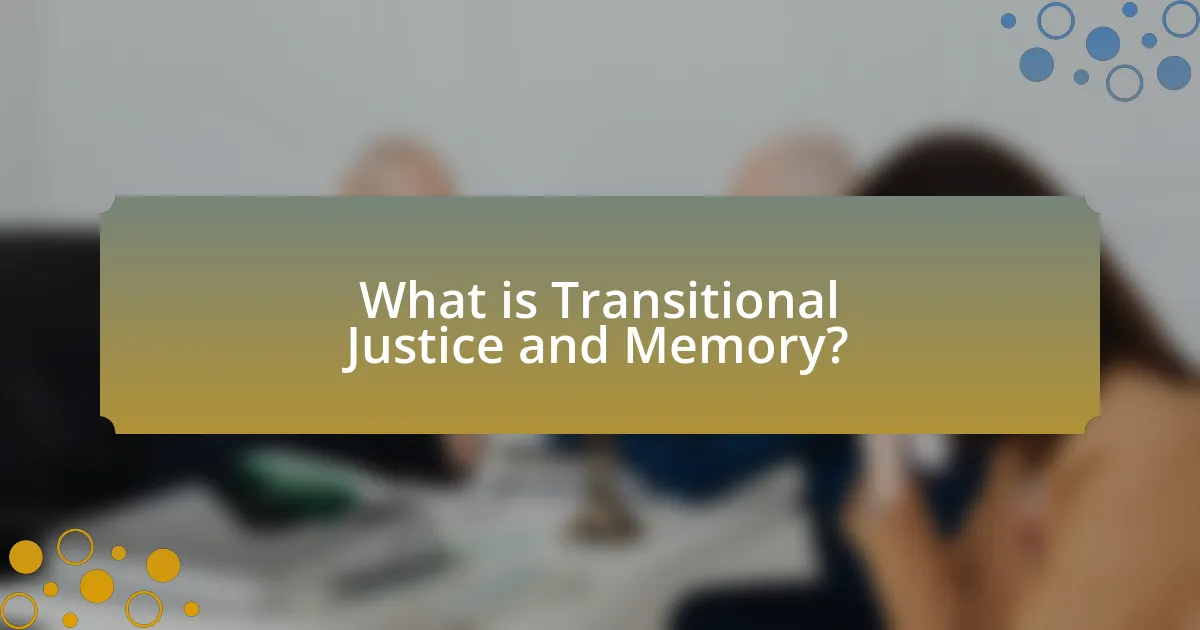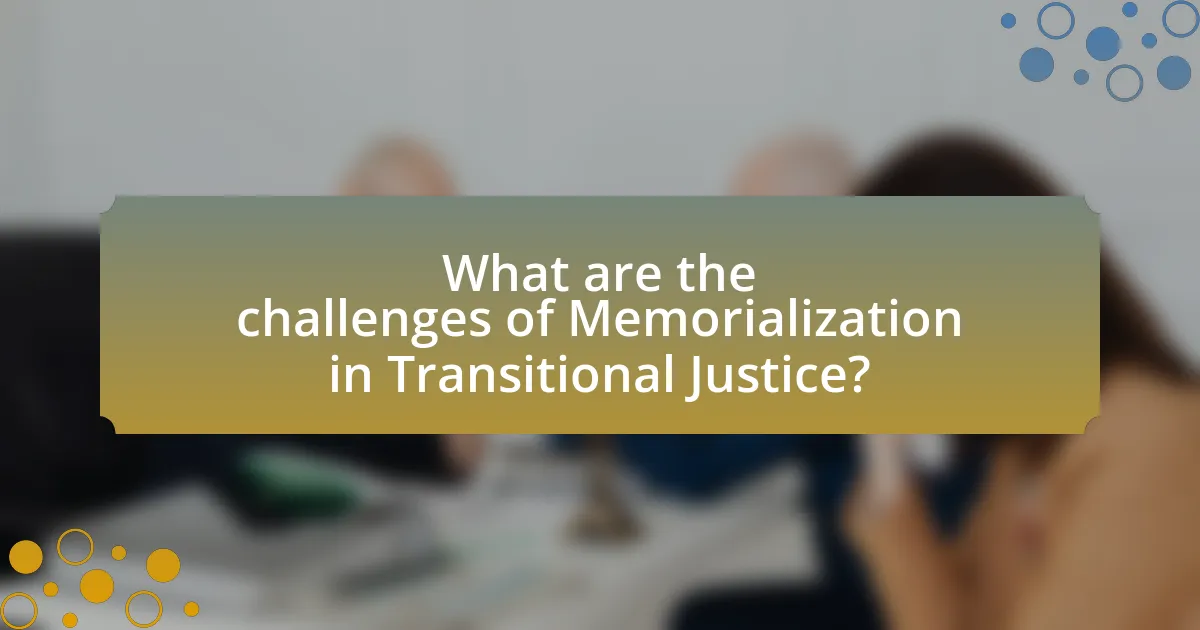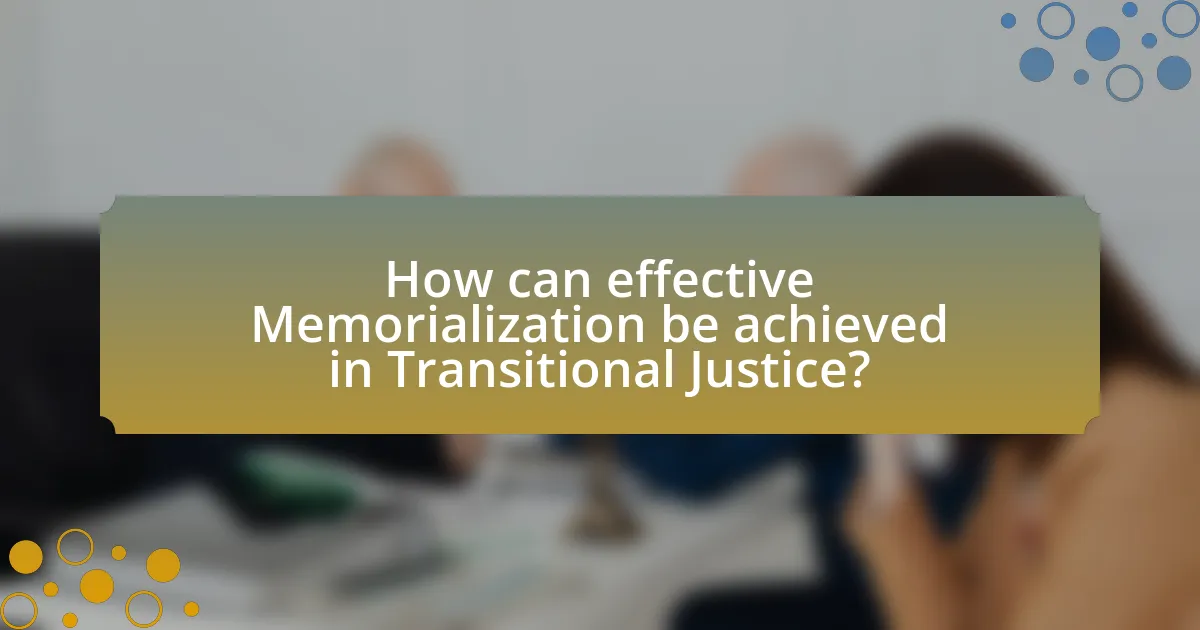Transitional justice encompasses judicial and non-judicial measures aimed at addressing human rights abuses and fostering accountability, reconciliation, and the rule of law. Memory is integral to this process, as it involves collective remembrance of past atrocities, which aids in acknowledging victims’ experiences and promoting societal healing. The article explores the intersection of transitional justice and memory, highlighting key concepts such as accountability, truth-seeking, reparations, and institutional reform. It emphasizes the importance of memorialization in facilitating healing and reconciliation, while also addressing challenges such as political resistance and differing narratives. Additionally, it discusses best practices for effective memorialization, the role of victims in shaping narratives, and lessons learned from both successful and failed memorialization efforts in various countries.

What is Transitional Justice and Memory?
Transitional justice refers to the set of judicial and non-judicial measures implemented by countries to address legacies of human rights abuses and promote accountability, reconciliation, and the rule of law. Memory plays a crucial role in transitional justice as it involves the collective remembrance of past atrocities, which is essential for acknowledging victims’ experiences and fostering societal healing. Research indicates that memorialization efforts, such as monuments and commemorative events, can significantly contribute to the process of reconciliation by ensuring that the past is not forgotten and that lessons are learned to prevent future violations. For instance, the Truth and Reconciliation Commission in South Africa emphasized the importance of memory in healing the nation post-apartheid, illustrating how remembering the past can facilitate a more just and equitable society.
How do Transitional Justice and Memory intersect?
Transitional justice and memory intersect through the process of addressing past human rights violations while fostering collective remembrance. Transitional justice mechanisms, such as truth commissions and reparations, aim to acknowledge and rectify injustices, which in turn shapes societal memory by creating a shared narrative of the past. For instance, the Truth and Reconciliation Commission in South Africa not only sought to uncover the truth about apartheid-era abuses but also played a crucial role in shaping national memory and promoting healing. This intersection is vital for building a foundation for future reconciliation and preventing the recurrence of violence, as it encourages societies to confront their histories rather than suppress them.
What are the key concepts of Transitional Justice?
The key concepts of Transitional Justice include accountability, truth-seeking, reparations, and institutional reform. Accountability refers to holding perpetrators of human rights violations responsible for their actions, which can involve criminal prosecutions or other forms of justice. Truth-seeking aims to uncover the facts about past abuses, often through truth commissions that document experiences and provide a historical record. Reparations involve compensating victims for their suffering, which can take the form of financial payments, services, or symbolic gestures. Institutional reform focuses on changing the structures and practices of state institutions to prevent future violations, ensuring that justice systems, police, and military are reformed to uphold human rights. These concepts are essential for societies transitioning from conflict or authoritarian rule to establish a foundation for peace and democracy.
How does Memory play a role in Transitional Justice?
Memory plays a crucial role in Transitional Justice by facilitating the acknowledgment of past atrocities and fostering collective healing. It serves as a foundation for truth-telling processes, allowing victims to share their experiences and ensuring that historical injustices are recognized. For instance, truth commissions, such as South Africa’s Truth and Reconciliation Commission, rely on collective memory to document human rights violations, which helps to validate victims’ narratives and promote societal reconciliation. This process not only honors the memories of those affected but also contributes to the establishment of a historical record that can prevent future abuses.
Why is Memorialization important in Transitional Justice?
Memorialization is important in Transitional Justice because it serves to acknowledge and honor the victims of past atrocities, fostering collective memory and promoting healing within affected communities. By creating memorials, societies can confront historical injustices, ensuring that the experiences of victims are recognized and remembered, which is essential for reconciliation. Research indicates that memorialization can help prevent the recurrence of violence by educating future generations about the past, as seen in countries like South Africa, where memorials have played a crucial role in the Truth and Reconciliation Commission process.
What are the different forms of memorialization?
The different forms of memorialization include physical monuments, commemorative events, digital memorials, and artistic expressions. Physical monuments, such as statues and plaques, serve as tangible reminders of significant events or individuals, often placed in public spaces to foster collective memory. Commemorative events, like memorial services or anniversaries, provide opportunities for communities to gather and reflect on shared histories. Digital memorials, which can be found on websites or social media platforms, allow for ongoing remembrance and engagement, often including personal stories and multimedia elements. Artistic expressions, such as literature, music, or visual art, convey the emotional and cultural significance of memories, contributing to the broader narrative of a society’s history. Each form plays a crucial role in shaping collective memory and facilitating healing in the context of transitional justice.
How does memorialization contribute to healing and reconciliation?
Memorialization contributes to healing and reconciliation by providing a space for collective remembrance and acknowledgment of past traumas. This process allows communities to confront their histories, fostering dialogue and understanding among diverse groups. Research indicates that memorials can facilitate emotional healing by validating the experiences of victims and survivors, which is essential for rebuilding trust and social cohesion. For instance, the Truth and Reconciliation Commission in South Africa emphasized the importance of memorials in acknowledging the suffering caused by apartheid, thereby promoting national healing and unity.

What are the challenges of Memorialization in Transitional Justice?
Memorialization in transitional justice faces several challenges, primarily including political resistance, differing narratives, and resource limitations. Political resistance often arises from those in power who may fear that memorialization could undermine their legitimacy or expose past atrocities. Differing narratives complicate the process, as various groups may have conflicting interpretations of events, making it difficult to create a unified memorial that is accepted by all stakeholders. Resource limitations, including funding and expertise, can hinder the establishment and maintenance of memorials, impacting their effectiveness in promoting healing and reconciliation. These challenges highlight the complexities involved in memorialization efforts within transitional justice frameworks.
How do political contexts affect memorialization efforts?
Political contexts significantly influence memorialization efforts by shaping the narratives and symbols that are deemed acceptable or legitimate. In authoritarian regimes, for instance, memorialization may be suppressed or manipulated to align with state ideologies, as seen in countries like North Korea, where monuments glorify the ruling family while erasing dissenting histories. Conversely, in democratic societies, memorialization often reflects a broader range of perspectives, allowing for the commemoration of marginalized groups, as evidenced by the establishment of memorials for victims of apartheid in South Africa. These contexts dictate not only what is remembered but also how it is remembered, impacting public discourse and collective memory.
What are the risks of politicizing memorials?
Politicizing memorials risks undermining their intended purpose of honoring victims and fostering collective healing. When memorials become tools for political agendas, they can alienate certain groups, provoke conflict, and distort historical narratives. For instance, memorials that emphasize specific political ideologies may marginalize other perspectives, leading to societal division. Additionally, politicization can result in the commodification of memory, where the significance of the memorial is overshadowed by political rhetoric, ultimately diminishing its emotional and historical value. This phenomenon has been observed in various contexts, such as the contentious debates surrounding memorials in post-conflict societies, where differing interpretations of history can exacerbate tensions rather than promote reconciliation.
How can communities navigate conflicting narratives in memorialization?
Communities can navigate conflicting narratives in memorialization by fostering inclusive dialogue and collaborative decision-making processes. Engaging diverse stakeholders, including marginalized voices, allows for a multifaceted understanding of historical events. For instance, the Truth and Reconciliation Commission in South Africa facilitated discussions that acknowledged various perspectives on apartheid, promoting healing and shared memory. This approach not only validates different experiences but also encourages collective ownership of memorialization efforts, ultimately leading to more comprehensive and representative memorials.
What role do victims play in the memorialization process?
Victims play a crucial role in the memorialization process by serving as the central figures whose experiences and narratives shape the collective memory of traumatic events. Their testimonies and stories are essential for creating memorials that honor their suffering and promote healing within communities. For instance, in post-apartheid South Africa, the Truth and Reconciliation Commission emphasized the importance of victim testimonies to acknowledge past injustices and foster national healing. This approach not only validates the victims’ experiences but also educates society about the consequences of violence and the need for justice, thereby reinforcing the significance of their role in memorialization.
How can victim narratives shape memorialization efforts?
Victim narratives can significantly shape memorialization efforts by providing personal accounts that humanize the experiences of those affected by violence or injustice. These narratives create a deeper emotional connection, fostering empathy and understanding among the public. For instance, the Truth and Reconciliation Commission in South Africa utilized victim testimonies to highlight the atrocities of apartheid, which informed the design and purpose of memorials, ensuring they reflect the lived experiences of victims. This approach not only honors the victims but also serves as a powerful tool for education and awareness, reinforcing the importance of remembering history to prevent future atrocities.
What are the implications of excluding certain voices from memorials?
Excluding certain voices from memorials can lead to a distorted historical narrative and marginalization of affected communities. This exclusion often results in a lack of representation for diverse perspectives, which can perpetuate existing power imbalances and social injustices. For instance, memorials that only honor dominant groups may ignore the experiences and suffering of marginalized populations, thereby reinforcing their invisibility in the collective memory. Research indicates that inclusive memorialization fosters reconciliation and healing, as seen in post-apartheid South Africa, where the Truth and Reconciliation Commission emphasized the importance of diverse narratives in memorials to address historical grievances. Thus, the implications of exclusion are significant, as they can hinder societal healing and perpetuate cycles of conflict.

How can effective Memorialization be achieved in Transitional Justice?
Effective memorialization in transitional justice can be achieved through inclusive community engagement and the establishment of memorial sites that honor victims. Engaging diverse community stakeholders ensures that the memorialization process reflects the experiences and narratives of all affected groups, fostering a sense of ownership and collective memory. For instance, the Truth and Reconciliation Commission in South Africa emphasized the importance of public hearings, allowing victims to share their stories, which contributed to a more comprehensive understanding of the past. Additionally, creating physical memorials, such as the Memorial to the Murdered Jews of Europe in Berlin, serves as a constant reminder of historical injustices and promotes public reflection. These approaches not only validate the experiences of victims but also encourage societal healing and reconciliation, demonstrating the critical role of memorialization in transitional justice.
What best practices exist for creating inclusive memorials?
Best practices for creating inclusive memorials include engaging diverse community stakeholders in the design process, ensuring representation of various narratives, and incorporating accessible features for all individuals. Engaging stakeholders allows for a broader range of perspectives, which can lead to a more comprehensive representation of the events being memorialized. For instance, the National Memorial for Peace and Justice in Montgomery, Alabama, involved input from local communities to accurately reflect the history of racial terror in the United States. Additionally, memorials should include multilingual inscriptions and tactile elements to accommodate different languages and abilities, promoting accessibility. Research indicates that inclusive memorials foster healing and reconciliation by acknowledging the experiences of marginalized groups, thereby enhancing the overall impact of the memorialization process.
How can community engagement enhance memorialization efforts?
Community engagement enhances memorialization efforts by fostering a sense of ownership and collective memory among participants. When communities actively participate in the design and implementation of memorials, they contribute personal narratives and cultural perspectives that enrich the memorial’s significance. Research indicates that inclusive memorialization processes lead to greater public support and emotional resonance, as seen in the case of the National September 11 Memorial & Museum, where community input shaped the memorial’s design and narrative. This collaborative approach not only honors the memories of those lost but also strengthens community bonds and promotes healing, demonstrating the vital role of engagement in effective memorialization.
What role does education play in the success of memorials?
Education plays a crucial role in the success of memorials by fostering awareness and understanding of the historical events they commemorate. Effective educational programs associated with memorials can enhance public engagement, ensuring that visitors grasp the significance of the memorial’s message. For instance, studies have shown that memorials with integrated educational initiatives, such as guided tours and informative displays, significantly increase visitor comprehension and emotional connection to the events being memorialized. This connection is vital for promoting reflection, dialogue, and healing within communities affected by past injustices, thereby reinforcing the memorial’s purpose and impact.
What lessons can be learned from successful memorialization examples?
Successful memorialization examples teach the importance of inclusivity, community engagement, and historical accuracy. Inclusivity ensures that diverse perspectives are represented, fostering a sense of belonging and recognition among various groups affected by historical events. Community engagement, as seen in projects like the National Memorial for Peace and Justice in the United States, emphasizes the role of local voices in shaping narratives, which enhances the memorial’s relevance and impact. Historical accuracy is crucial, as evidenced by the Holocaust Memorial in Berlin, which confronts the complexities of history rather than simplifying them, allowing for a deeper understanding of the past. These lessons highlight that effective memorialization not only honors victims but also promotes healing and reconciliation within society.
Which countries have effectively implemented memorialization in Transitional Justice?
Countries that have effectively implemented memorialization in Transitional Justice include South Africa, Rwanda, and Germany. South Africa established the Truth and Reconciliation Commission, which emphasized memorialization through public hearings and memorial sites to acknowledge past injustices. Rwanda created the Genocide Memorials, which serve to honor victims and educate future generations about the 1994 genocide. Germany has implemented various memorials and educational programs to confront its Nazi past, ensuring that the memory of victims is preserved and recognized. These examples illustrate how memorialization can play a crucial role in the process of healing and reconciliation in post-conflict societies.
What can be learned from failures in memorialization efforts?
Failures in memorialization efforts reveal critical insights about the importance of community involvement and the need for inclusive narratives. When memorials do not resonate with the affected communities, they often fail to achieve their intended purpose of healing and remembrance. For instance, the failure of the Vietnam Veterans Memorial to initially include the perspectives of all veterans highlighted the necessity of diverse voices in memorialization. This underscores that successful memorials must reflect the complexities of history and engage with the communities they aim to honor. Additionally, failures can indicate the consequences of political agendas overshadowing genuine remembrance, as seen in various state-sponsored memorials that lack public support. Thus, learning from these failures emphasizes the need for collaborative processes and authentic representation in memorialization efforts.
What practical steps can communities take to promote effective memorialization?
Communities can promote effective memorialization by establishing inclusive memorial committees that represent diverse perspectives and experiences. These committees can engage in community consultations to gather input on memorial design and purpose, ensuring that the memorial reflects the collective memory and values of the community. Research shows that participatory approaches in memorialization foster a sense of ownership and connection among community members, enhancing the memorial’s significance. Additionally, communities can organize educational programs and events around the memorial to facilitate ongoing dialogue about the historical events it commemorates, thereby reinforcing its relevance and impact.


